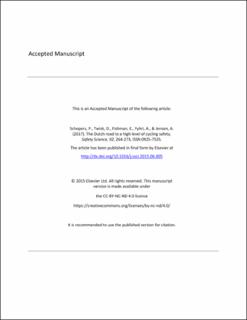| dc.contributor.author | Schepers, Paul | |
| dc.contributor.author | Twisk, D | |
| dc.contributor.author | Fishman, E | |
| dc.contributor.author | Fyhri, Aslak | |
| dc.contributor.author | Jensen, A | |
| dc.coverage.spatial | Netherlands | en_US |
| dc.date.accessioned | 2021-08-04T14:14:12Z | |
| dc.date.available | 2021-08-04T14:14:12Z | |
| dc.date.created | 2017-01-30T09:43:47Z | |
| dc.date.issued | 2015-06-22 | |
| dc.identifier.citation | Safety Science. 2017, 92 (February), 264-273. | en_US |
| dc.identifier.issn | 0925-7535 | |
| dc.identifier.uri | https://hdl.handle.net/11250/2766251 | |
| dc.description.abstract | Many governments attempt to improve cycling safety to reduce the number of bicycle crashes and encourage cycling. The Netherlands is a world leader in bicycle use and safety. This paper explores how the Netherlands achieved an 80% reduction in the number of cyclists killed (predominantly bicycle–motor vehicle crashes) per billion bicycle kilometres over a thirty year period. Factors found to contribute to this improvement include the establishment of a road hierarchy with large traffic-calmed areas where through traffic is kept out. A heavily used freeway network shifts motor vehicles from streets with high cycling levels. This reduces exposure to high-speed motor vehicles. Separated bicycle paths and intersection treatments decrease the likelihood of bicycle–motor vehicle crashes. The high amount of bicycle use increases safety as a higher bicycle modal share corresponds with a lower share of driving and greater awareness of cyclists among drivers. Low cycling speed was also found to contribute to the high level of cycling safety in the Netherlands. | en_US |
| dc.language.iso | eng | en_US |
| dc.publisher | Elsevier | en_US |
| dc.rights | Attribution-NonCommercial-NoDerivatives 4.0 Internasjonal | * |
| dc.rights.uri | http://creativecommons.org/licenses/by-nc-nd/4.0/deed.no | * |
| dc.title | The Dutch road to a high level of cycling safety | en_US |
| dc.type | Peer reviewed | en_US |
| dc.type | Journal article | en_US |
| dc.rights.holder | © 2015 Elsevier Ltd. All rights reserved. | en_US |
| dc.description.version | acceptedVersion | en_US |
| cristin.ispublished | true | |
| cristin.fulltext | postprint | |
| cristin.qualitycode | 2 | |
| dc.identifier.doi | 10.1016/j.ssci.2015.06.005 | |
| dc.identifier.cristin | 1440662 | |
| dc.source.journal | Safety Science | en_US |
| dc.source.volume | 92 | en_US |
| dc.source.issue | February | en_US |
| dc.source.pagenumber | 264-273 | en_US |

